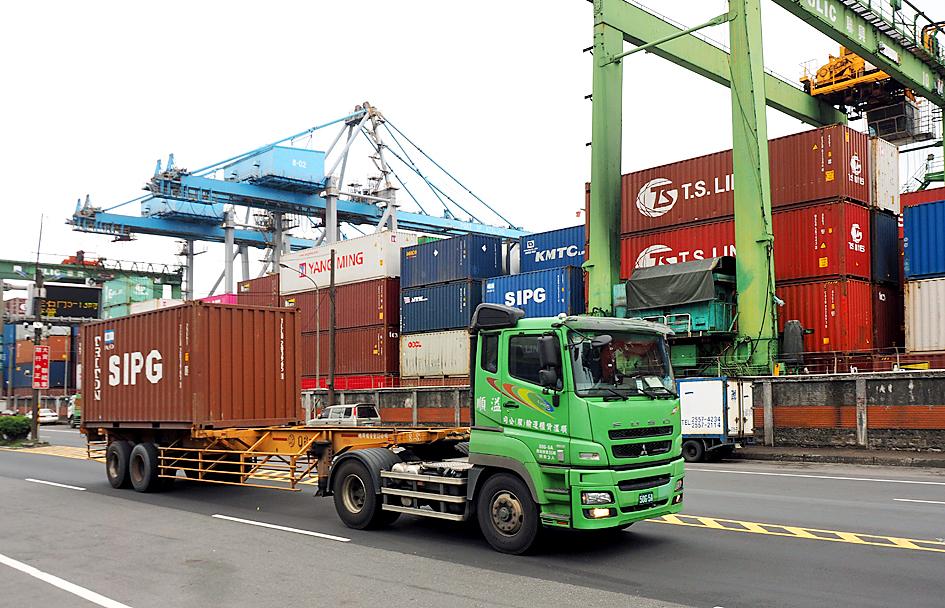The nation’s exports last month declined 2 percent year-on-year to US$27 billion, as cheaper crude oil prices dampened sales of products heavily reliant on raw materials, overshadowing shipments of electronic components, the Ministry of Finance said yesterday.
It was the third straight month the critical economic gauge remained negative and exports might not improve this month or even for the rest of this year, Department of Statistics Director-General Beatrice Tsai (蔡美娜) told a news conference in Taipei.
“The COVID-19 pandemic continued to weigh on sales of products using raw materials, as seen in a 57.3 percent plunge in exports of mineral products,” Tsai said.

Photo: David Chang, EPA-EFE
Likewise, shipments of base metals, plastic and chemical products dropped 15.2 percent, 19.9 percent and 15.6 percent year-on-year respectively, the ministry said in a report.
Exports of textile products slumped 35.1 percent, the second-worst fall since records began, as inventory remained high amid lockdowns in ASEAN and other markets, Tsai said.
However, shipments of electronic components continued to gain traction, logging a 13.2 percent increase to a record high of US$10.24 billion on fast-growing 5G deployment, as well as remote working and learning, she said.
Exports of semiconductors increased 14.2 percent to US$9.2 billion, while those of information and communications products rose 10.9 percent to US$3.95 billion, she said.
Remote learning and working from home might continue at many organizations and companies, boosting demand for data centers, servers and laptops, Tsai said.
Meanwhile, international technology giants pressed ahead with the launch of 5G wireless gadgets, despite the COVID-19 pandemic, providing business opportunities for local companies in their supply chains, she said.
“If the reopening of the economies in Europe and the US goes well, the electronics industry could perform better than expected in the second half of the year,” Singapore-based Barclays Bank PLC economist Angela Hsieh (謝涵涵) said.
“The biggest uncertainty comes from US-China relations, but the impact of that seems limited so far,” Hsieh added.
Exports to China and the US rose the most, gaining 10.6 percent and 9.3 percent respectively, while China accounted for 44.9 percent of overall exports, the ministry said.
Imports fell 3.5 percent to US$22.28 billion, mainly dragged down by cheaper crude oil prices that plummeted 63 percent year-on-year, Tsai said.
However, imports of capital equipment rose 14.2 percent to US$3.7 billion, as local firms, especially semiconductor makers, stood by their plans to upgrade and expand, she said.
The nation posted a trade surplus of US$4.72 billion for last month, a 5.6 percent increase from a year earlier.
The outlook is unlikely to become clear until global economies emerge from the pandemic, Tsai said, adding that exports would decline 2 to 5 percent this month.
That would suggest a decline in second-quarter exports from a year earlier.
In the first five months of this year, cumulative exports rose 1.5 percent to US$130.91 billion, while cumulative imports increased 1.4 percent to US$114.4 billion, creating a trade surplus of US$16.51 billion, the report showed.
Additional reporting by Bloomberg

MULTIFACETED: A task force has analyzed possible scenarios and created responses to assist domestic industries in dealing with US tariffs, the economics minister said The Executive Yuan is tomorrow to announce countermeasures to US President Donald Trump’s planned reciprocal tariffs, although the details of the plan would not be made public until Monday next week, Minister of Economic Affairs J.W. Kuo (郭智輝) said yesterday. The Cabinet established an economic and trade task force in November last year to deal with US trade and tariff related issues, Kuo told reporters outside the legislature in Taipei. The task force has been analyzing and evaluating all kinds of scenarios to identify suitable responses and determine how best to assist domestic industries in managing the effects of Trump’s tariffs, he

TIGHT-LIPPED: UMC said it had no merger plans at the moment, after Nikkei Asia reported that the firm and GlobalFoundries were considering restarting merger talks United Microelectronics Corp (UMC, 聯電), the world’s No. 4 contract chipmaker, yesterday launched a new US$5 billion 12-inch chip factory in Singapore as part of its latest effort to diversify its manufacturing footprint amid growing geopolitical risks. The new factory, adjacent to UMC’s existing Singapore fab in the Pasir Res Wafer Fab Park, is scheduled to enter volume production next year, utilizing mature 22-nanometer and 28-nanometer process technologies, UMC said in a statement. The company plans to invest US$5 billion during the first phase of the new fab, which would have an installed capacity of 30,000 12-inch wafers per month, it said. The

In a small town in Paraguay, a showdown is brewing between traditional producers of yerba mate, a bitter herbal tea popular across South America, and miners of a shinier treasure: gold. A rush for the precious metal is pitting mate growers and indigenous groups against the expanding operations of small-scale miners who, until recently, were their neighbors, not nemeses. “They [the miners] have destroyed everything... The canals, springs, swamps,” said Vidal Britez, president of the Yerba Mate Producers’ Association of the town of Paso Yobai, about 210km east of capital Asuncion. “You can see the pollution from the dead fish.

Taiwan’s official purchasing managers’ index (PMI) last month rose 0.2 percentage points to 54.2, in a second consecutive month of expansion, thanks to front-loading demand intended to avoid potential US tariff hikes, the Chung-Hua Institution for Economic Research (CIER, 中華經濟研究院) said yesterday. While short-term demand appeared robust, uncertainties rose due to US President Donald Trump’s unpredictable trade policy, CIER president Lien Hsien-ming (連賢明) told a news conference in Taipei. Taiwan’s economy this year would be characterized by high-level fluctuations and the volatility would be wilder than most expect, Lien said Demand for electronics, particularly semiconductors, continues to benefit from US technology giants’ effort